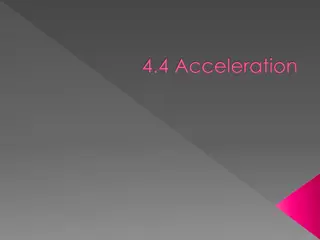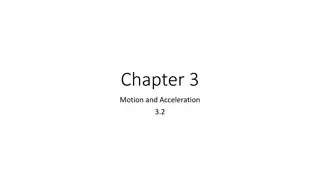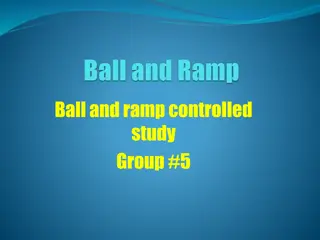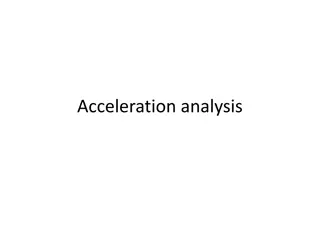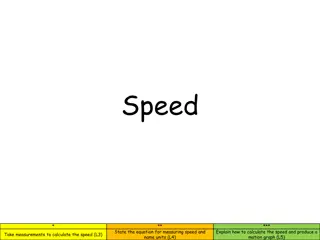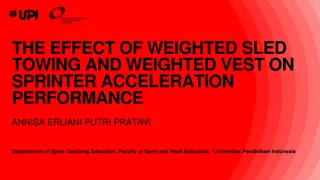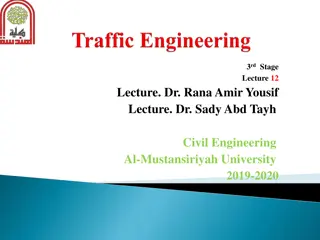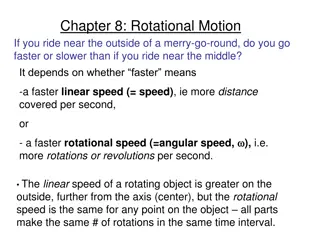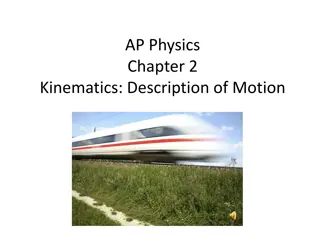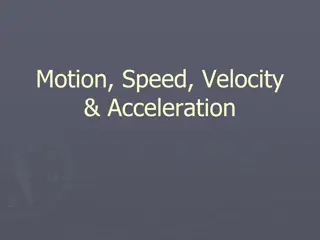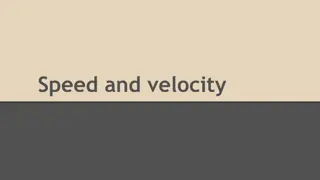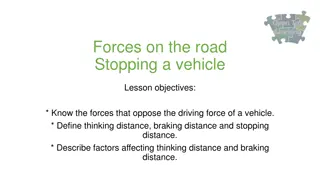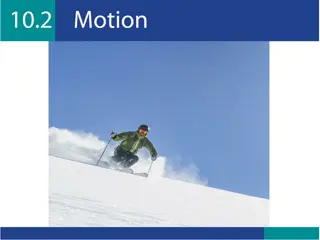Understanding Distance, Speed, and Acceleration in Physics
Explore the concepts of distance, speed, and acceleration in physics with practical examples and calculations. Learn how to calculate speed, interpret distance-time graphs, differentiate between speed and velocity, and understand acceleration through scenarios involving various moving objects. Gain insights into the relationships between distance, time, and velocity to enhance your understanding of motion in physics.
Download Presentation

Please find below an Image/Link to download the presentation.
The content on the website is provided AS IS for your information and personal use only. It may not be sold, licensed, or shared on other websites without obtaining consent from the author. Download presentation by click this link. If you encounter any issues during the download, it is possible that the publisher has removed the file from their server.
E N D
Presentation Transcript
Distance, speed and acceleration WJEC Physics Unit 2 - 2.1 WJEC Science (Double Award) Unit 6 - 6.1
Distance, speed and acceleration S Speed = distance (metres) V t time (seconds) Click here for the answers 1) 2) 3) Aled walks 200m in 40s. What is his speed? Lowri travels 2km in 1000s. What is her speed? How long would it take for Dafydd to run 100m if he runs at a speed of 10m/s? Heledd travels at a speed of 50m/s for 20s. How far does she travel? A car travels at a speed of 85 mph (about 40m/s). How long would it take for him to travel 20km? 1) 5m/s 2) 2m/s 3) 10s 4) 1000m/s 5) 500s 4) 5)
Distance Distance- -Time Graphs Time Graphs 2) Straight horizontal line = 4) Straight line at a downwards angle = Constant speed in Constant speed in reverse reverse 40 Motionless Motionless 30 Distance (metres) 20 10 Time/s 0 20 40 60 80 3) Straight line at a greater angle upwards = Constant speed forwards (high) Constant speed forwards (high) 100 1) Straight line at an upwards angle = Constant speed forwards (low) Constant speed forwards (low)
40 30 Distance (m) 20 10 0 Time (s) 20 40 60 80 100 Click here for the answers 1) 2) What is the speed during the first 20s? How far is the object from the start after 60 seconds? What is the speed during the last 40s? When was the object travelling at its fastest? 1) 0.5m/s 2) 40m 3) 2m/s in reverse 4) 40 60s 3) 4)
Speed v Velocity Speed v Velocity Simply, speed is the distance travelled per second This car s speed is 20m/s Velocity is the distance travelled per second in a specific direction .. Speed of 20m/s to the right
Acceleration Acceleration acceleration (m/s2) =change in velocity (m/s) time (s) V - U a t 1) A biker speeds up from 0 to 10m/s in 5 s. What is the acceleration? A ball is dropped with an acceleration of 10m/s2 for 12s. By how much will the velocity of the ball change? A car speeds up from 10 to 20m/s with an acceleration of 2m/s2. How much time did this change take? A rocket speeds up from 1 000m/s to 5 000m/s in 2s. What is its velocity? 2) Click here for the answers 1) 2m/s2 2) 120m/s 3) 5s 4) 2000m/s2 3) 4)
Velocity Velocity- -Time Graphs Time Graphs Line at an upwards angle = acceleration acceleration 1) Constant Constant 80 4) Line at a downwards angle = Constant deceleration Constant deceleration 60 velocity (m/s) 40 20 0 t(s) 10 20 30 40 3) Line at an upwards angle = Constant acceleration (lower) Constant acceleration (lower) 50 2) Horizontal line = Constant velocity Constant velocity
Calculating the Distance Calculating the Distance 80 60 Velocity (m/s) 40 20 t/s 0 10 20 30 40 50 Chapter 15 To calculate the total distance of the journey, you must calculate the area under the graph.
80 60 Velocity (m/s) 40 20 t/s 0 10 20 30 40 50 Click here for the answers 1) 2) What is the velocity after 10s? What is the acceleration between 20 a 30s? What is the deceleration between 30 and 50s? What was the distance of the journey? 1) 40m/s 2) 2m/s2 3) 3m/s2 4) 1700m 3) 4)
Braking Distances for a car A car s braking distance is composed of two elements: 1) The thinking distance this is the distance you travel whilst reacting. 2) Braking distance this is the distance travelled whilst braking. Thinking distance 9m Braking distance 14m Total 23m 13m/s (30 m.p.h.) 38m 15m 53m 22m/s (50 m.p.h.) 21m 75m 31m/s (70 m.p.h.) 96m You do not need to learn the above figures for the exam, but they show how the car s speed affect its stopping distance. What else affects a car s stopping distance?
A Cars Stopping Distance High speed Tiredness Thinking distance Alcohol Drugs Impaired vision Ice on the road Wet road surface Braking distance Worn tyres or brakes High speed
A cars stopping distance Visit the website below to see video clips on the effects of speed, tiredness, alcohol misuse etc. on the stopping distance. http://think.direct.gov.uk http://think.direct.gov.uk


